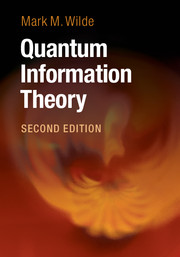Book contents
- Frontmatter
- Contents
- Preface to the Second Edition
- Preface to the First Edition
- How To Use This Book
- Part I Introduction
- Part II The Quantum Theory
- Part III Unit Quantum Protocols
- Part IV Tools of Quantum Shannon Theory
- Part V Noiseless Quantum Shannon Theory
- Part VI Noisy Quantum Shannon Theory
- Introduction
- 20 Classical Communication
- 21 Entanglement-Assisted Classical Communication
- 22 Coherent Communication with Noisy Resources
- 23 Private Classical Communication
- 24 Quantum Communication
- 25 Trading Resources for Communication
- 26 Summary and Outlook
- Appendix A Supplementary Results
- Appendix B Unique Linear Extension of a Quantum Physical Evolution
- References
- Index
25 - Trading Resources for Communication
from Part VI - Noisy Quantum Shannon Theory
Published online by Cambridge University Press: 16 February 2017
- Frontmatter
- Contents
- Preface to the Second Edition
- Preface to the First Edition
- How To Use This Book
- Part I Introduction
- Part II The Quantum Theory
- Part III Unit Quantum Protocols
- Part IV Tools of Quantum Shannon Theory
- Part V Noiseless Quantum Shannon Theory
- Part VI Noisy Quantum Shannon Theory
- Introduction
- 20 Classical Communication
- 21 Entanglement-Assisted Classical Communication
- 22 Coherent Communication with Noisy Resources
- 23 Private Classical Communication
- 24 Quantum Communication
- 25 Trading Resources for Communication
- 26 Summary and Outlook
- Appendix A Supplementary Results
- Appendix B Unique Linear Extension of a Quantum Physical Evolution
- References
- Index
Summary
This chapter unifies all of the channel coding theorems that we have studied in this book. One of the most general information-processing tasks that a sender and receiver can accomplish is to transmit classical and quantum information and generate entanglement with many independent uses of a quantum channel and with the assistance of classical communication, quantum communication, and shared entanglement.1 The resulting rates for communication are net rates that give the generation rate of a resource less its consumption rate. Since we have three resources, all achievable rates are rate triples (C,Q,E) that lie in a three-dimensional capacity region, where C is the net rate of classical communication, Q is the net rate of quantum communication, and E is the net rate of entanglement consumption/generation. The capacity theorem for this general scenario is known as the quantum dynamic capacity theorem, and it is the main theorem that we prove in this chapter. All of the rates given in the channel coding theorems of previous chapters are special points in this three-dimensional capacity region.
The proof of the quantum dynamic capacity theorem comes in two parts: the direct coding theorem and the converse theorem. The direct coding theorem demonstrates that the strategy for achieving any point in the three-dimensional capacity region is remarkably simple: we just combine the protocol from Corollary 22.5.2 for entanglement-assisted classical and quantum communication with the three unit protocols of teleportation, super-dense coding, and entanglement distribution. The interpretation of the achievable rate region is that it is the unit resource capacity region from Chapter 8 translated along the points achievable with the protocol from Corollary 22.5.2. In the proof of the converse theorem, we analyze the most general protocol that can consume and generate classical communication, quantum communication, and entanglement along with the consumption of many independent uses of a quantum channel, and we show that the net rates for such a protocol are bounded by the regularization of the achievable rate region.
- Type
- Chapter
- Information
- Quantum Information Theory , pp. 679 - 716Publisher: Cambridge University PressPrint publication year: 2017

